turn signal TOYOTA CAMRY HYBRID 2018 Owners Manual (in English)
[x] Cancel search | Manufacturer: TOYOTA, Model Year: 2018, Model line: CAMRY HYBRID, Model: TOYOTA CAMRY HYBRID 2018Pages: 596, PDF Size: 10.01 MB
Page 3 of 596
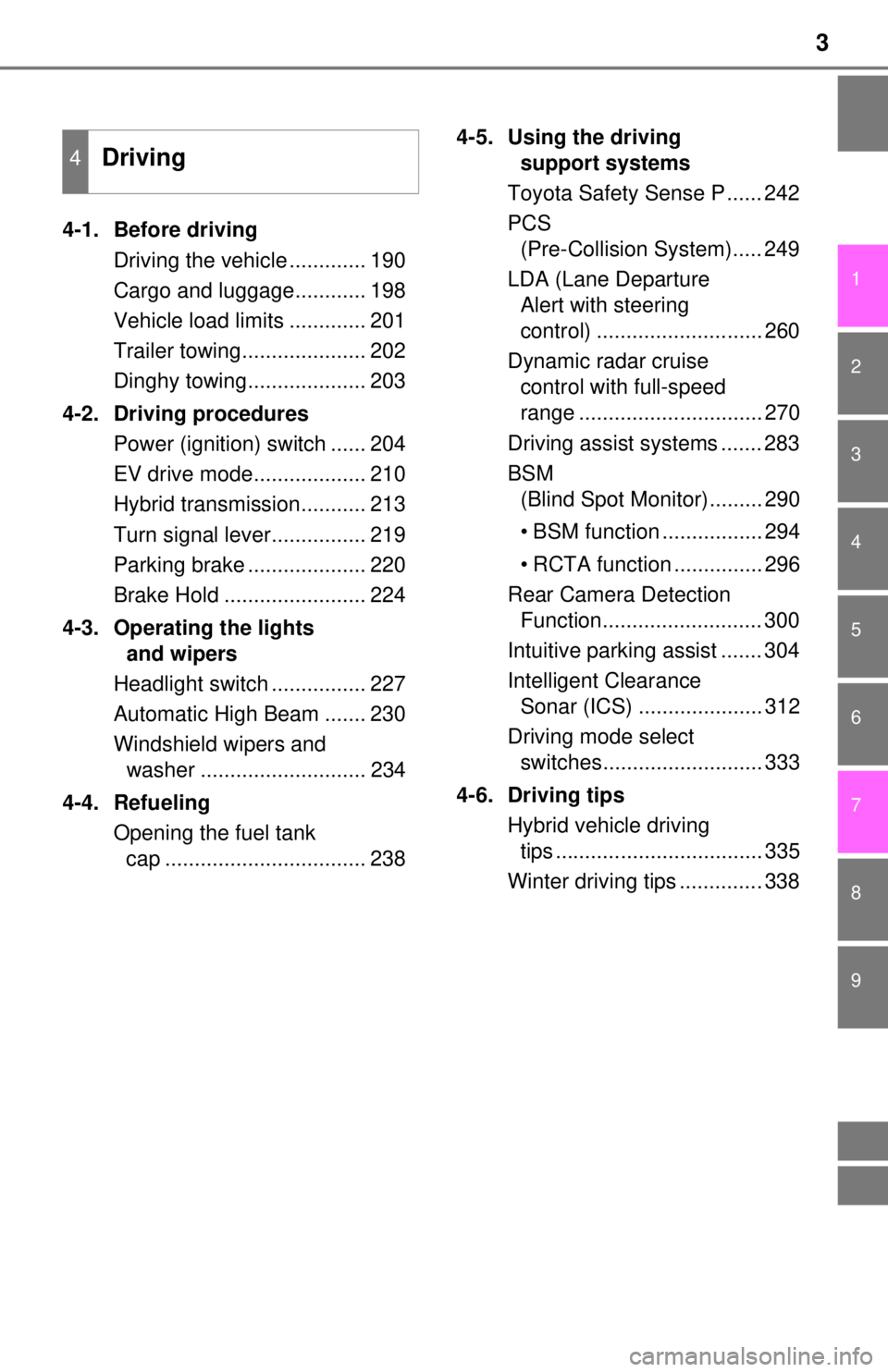
3
1
9 7 6
5
4
3
2
8
4-1. Before drivingDriving the vehicle ............. 190
Cargo and luggage............ 198
Vehicle load limits ............. 201
Trailer towing..................... 202
Dinghy towing.................... 203
4-2. Driving procedures Power (ignition) switch ...... 204
EV drive mode................... 210
Hybrid transmission........... 213
Turn signal lever................ 219
Parking brake .................... 220
Brake Hold ........................ 224
4-3. Operating the lights and wipers
Headlight switch ................ 227
Automatic High Beam ....... 230
Windshield wipers and washer ............................ 234
4-4. Refueling Opening the fuel tank cap .................................. 238 4-5. Using the driving
support systems
Toyota Safety Sense P ...... 242
PCS (Pre-Collision System)..... 249
LDA (Lane Departure Alert with steering
control) ............................ 260
Dynamic radar cruise control with full-speed
range ............................... 270
Driving assist systems ....... 283
BSM (Blind Spot Monitor)......... 290
• BSM function ................. 294
• RCTA function ............... 296
Rear Camera Detection Function........................... 300
Intuitive parking assist ....... 304
Intelligent Clearance Sonar (ICS) ..................... 312
Driving mode select switches........................... 333
4-6. Driving tips Hybrid vehicle driving tips ................................... 335
Winter driving tips .............. 338
4Driving
Page 15 of 596
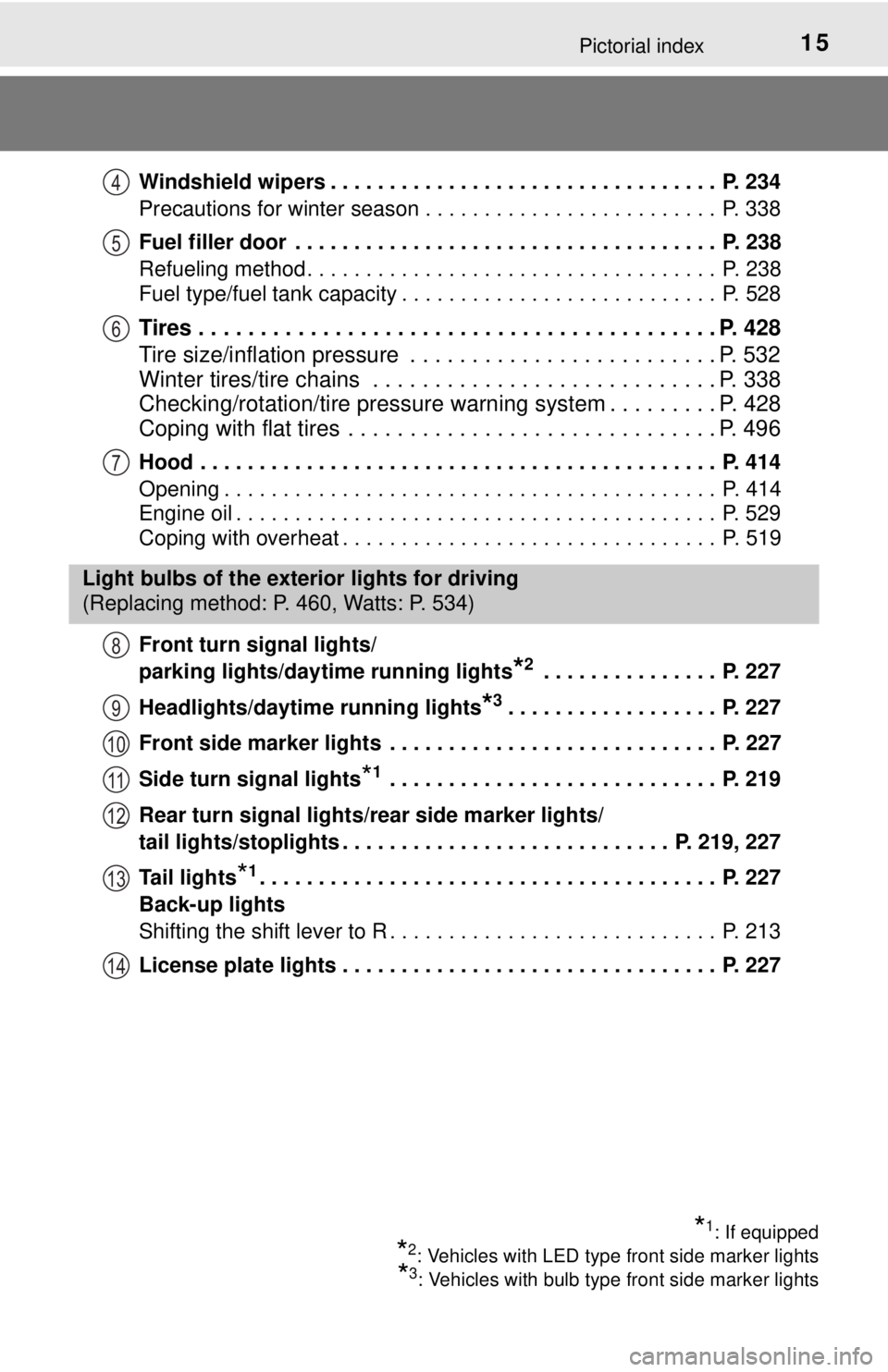
15Pictorial index
Windshield wipers . . . . . . . . . . . . . . . . . . . . . . . . . . . . . . . . . P. 234
Precautions for winter season . . . . . . . . . . . . . . . . . . . . . . . . . P. 338
Fuel filler door . . . . . . . . . . . . . . . . . . . . . . . . . . . . . . . . . . . . P. 238
Refueling method . . . . . . . . . . . . . . . . . . . . . . . . . . . . . . . . . . . P. 238
Fuel type/fuel tank capacity . . . . . . . . . . . . . . . . . . . . . . . . . . . P. 528
Tires . . . . . . . . . . . . . . . . . . . . . . . . . . . . . . . . . . . . . . . . . . P. 428
Tire size/inflation pressure . . . . . . . . . . . . . . . . . . . . . . . . . P. 532
Winter tires/tire chains . . . . . . . . . . . . . . . . . . . . . . . . . . . . P. 338
Checking/rotation/tire pressure warning system . . . . . . . . . P. 428
Coping with flat tires . . . . . . . . . . . . . . . . . . . . . . . . . . . . . . P. 496
Hood . . . . . . . . . . . . . . . . . . . . . . . . . . . . . . . . . . . . . . . . . . . . P. 414
Opening . . . . . . . . . . . . . . . . . . . . . . . . . . . . . . . . . . . . . . . . . . P. 414
Engine oil . . . . . . . . . . . . . . . . . . . . . . . . . . . . . . . . . . . . . . . . . P. 529
Coping with overheat . . . . . . . . . . . . . . . . . . . . . . . . . . . . . . . . P. 519
Front turn signal lights/
parking lights/daytime running lights
*2 . . . . . . . . . . . . . . . P. 227
Headlights/daytime running lights
*3. . . . . . . . . . . . . . . . . . P. 227
Front side marker lights . . . . . . . . . . . . . . . . . . . . . . . . . . . . P. 227
Side turn signal lights
*1 . . . . . . . . . . . . . . . . . . . . . . . . . . . . P. 219
Rear turn signal lights/r ear side marker lights/
tail lights/stoplights . . . . . . . . . . . . . . . . . . . . . . . . . . . . P. 219, 227
Tail lights
*1. . . . . . . . . . . . . . . . . . . . . . . . . . . . . . . . . . . . . . . P. 227
Back-up lights
Shifting the shift lever to R . . . . . . . . . . . . . . . . . . . . . . . . . . . . P. 213
License plate lights . . . . . . . . . . . . . . . . . . . . . . . . . . . . . . . . P. 227
4
5
6
7
Light bulbs of the exterior lights for driving
(Replacing method: P. 460, Watts: P. 534)
8
9
10
11
12
13
14
*1: If equipped
*2: Vehicles with LED type front side marker lights
*3: Vehicles with bulb type front side marker lights
Page 17 of 596
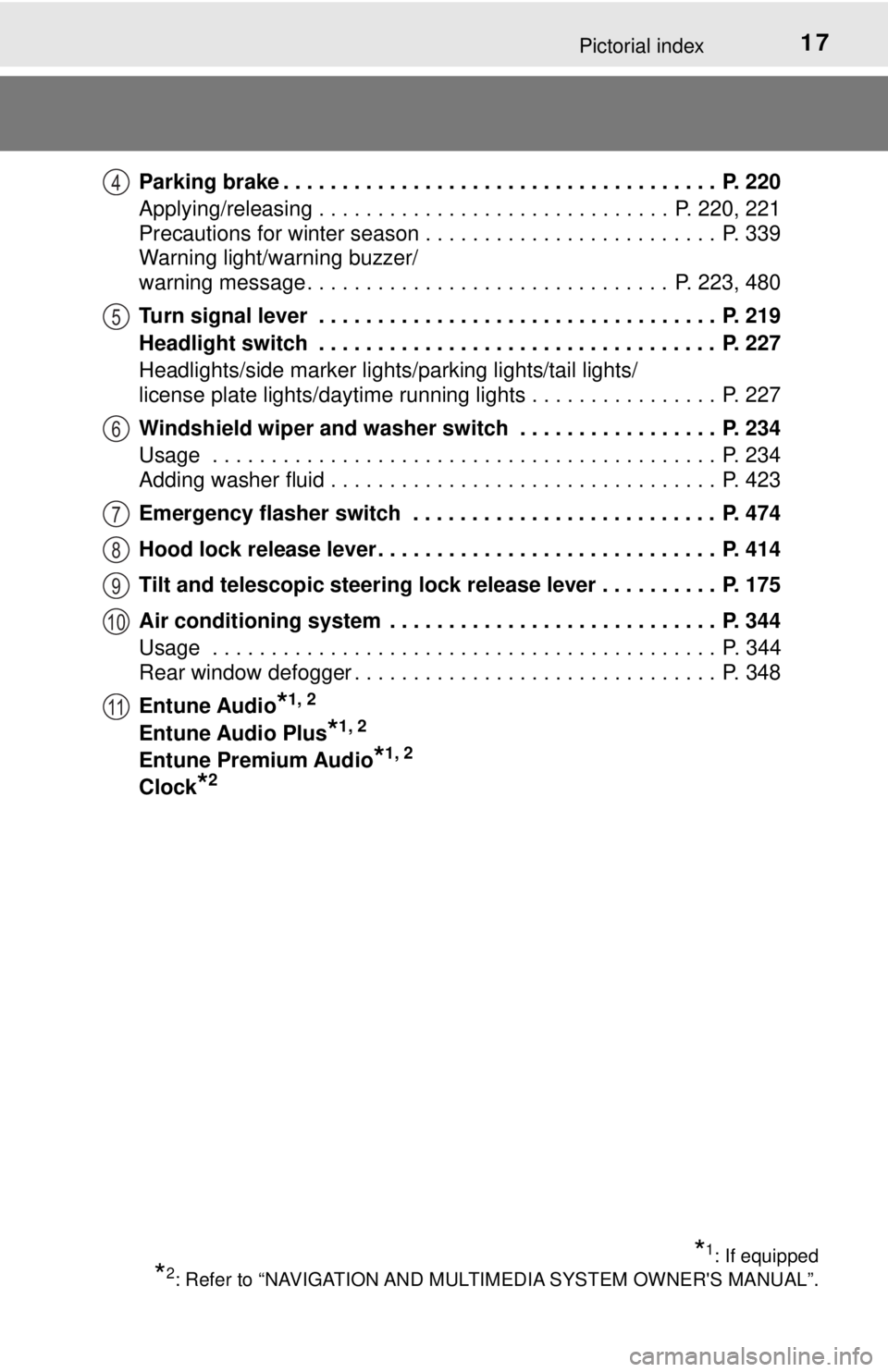
17Pictorial index
Parking brake . . . . . . . . . . . . . . . . . . . . . . . . . . . . . . . . . . . . . P. 220
Applying/releasing . . . . . . . . . . . . . . . . . . . . . . . . . . . . . . P. 220, 221
Precautions for winter season . . . . . . . . . . . . . . . . . . . . . . . . . P. 339
Warning light/warning buzzer/
warning message . . . . . . . . . . . . . . . . . . . . . . . . . . . . . . . P. 223, 480
Turn signal lever . . . . . . . . . . . . . . . . . . . . . . . . . . . . . . . . . . P. 219
Headlight switch . . . . . . . . . . . . . . . . . . . . . . . . . . . . . . . . . . P. 227
Headlights/side marker lights/parking lights/tail lights/
license plate lights/daytime running lights . . . . . . . . . . . . . . . . P. 227
Windshield wiper and washer switch . . . . . . . . . . . . . . . . . P. 234
Usage . . . . . . . . . . . . . . . . . . . . . . . . . . . . . . . . . . . . . . . . . . . P. 234
Adding washer fluid . . . . . . . . . . . . . . . . . . . . . . . . . . . . . . . . . P. 423
Emergency flasher switch . . . . . . . . . . . . . . . . . . . . . . . . . . P. 474
Hood lock release lever. . . . . . . . . . . . . . . . . . . . . . . . . . . . . P. 414
Tilt and telescopic steering lock release lever . . . . . . . . . . P. 175
Air conditioning system . . . . . . . . . . . . . . . . . . . . . . . . . . . . P. 344
Usage . . . . . . . . . . . . . . . . . . . . . . . . . . . . . . . . . . . . . . . . . . . P. 344
Rear window defogger . . . . . . . . . . . . . . . . . . . . . . . . . . . . . . . P. 348
Entune Audio
*1, 2
Entune Audio Plus*1, 2
Entune Premium Audio*1, 2
Clock*2
4
5
6
7
8
9
10
11
*1: If equipped
*2: Refer to “NAVIGATION AND MULTIMEDIA SYSTEM OWNER'S MANUAL”.
Page 93 of 596
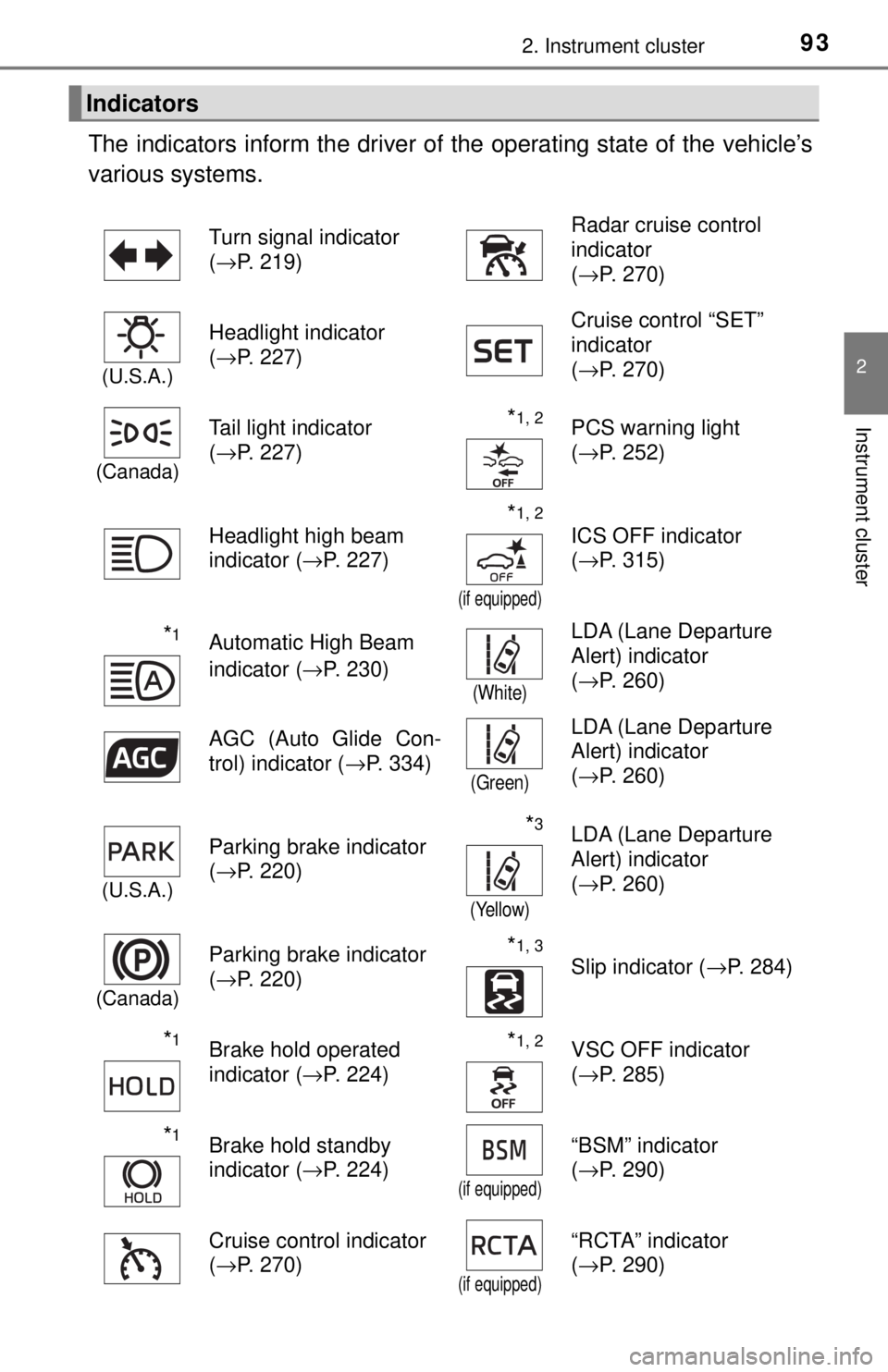
932. Instrument cluster
2
Instrument cluster
The indicators inform the driver of the operating state of the vehicle’s
various systems.
Indicators
Turn signal indicator
( →P. 219) Radar cruise control
indicator
(
→P. 270)
(U.S.A.)
Headlight indicator
(→P. 227) Cruise control “SET”
indicator
(
→P. 270)
(Canada)
Tail light indicator
(→P. 227) *1, 2PCS warning light
(→P. 252)
Headlight high beam
indicator ( →P. 227)
*1, 2
(if equipped)
ICS OFF indicator
(→P. 315)
*1Automatic High Beam
indicator ( →P. 230)
(White)
LDA (Lane Departure
Alert) indicator
(→P. 260)
AGC (Auto Glide Con-
trol) indicator ( →P. 334)
(Green)
LDA (Lane Departure
Alert) indicator
(→P. 260)
(U.S.A.)
Parking brake indicator
(→P. 220)*3
(Yellow)
LDA (Lane Departure
Alert) indicator
(→P. 260)
(Canada)
Parking brake indicator
(→P. 220)*1, 3
Slip indicator ( →P. 284)
*1Brake hold operated
indicator (→P. 224)*1, 2VSC OFF indicator
(→P. 285)
*1Brake hold standby
indicator ( →P. 224)
(if equipped)
“BSM” indicator
(→P. 290)
Cruise control indicator
( →P. 270)
(if equipped)
“RCTA” indicator
(→P. 290)
Page 164 of 596

1643-2. Opening, closing and locking the doors
■Note for the entry function
●Even when the electronic key is within the effective range (detection areas),
the system may not operate properly in the following cases:
• The electronic key is too close to the window or outside door handle, near
the ground, or in a high place when the doors are locked or unlocked.
• The electronic key is near the ground or in a high place, or too close to
the rear bumper center when the trunk is opened.
• The electronic key is on the instrument panel, rear package tray or floor, or in the door pockets or glove box when the hybrid system is started or
power switch modes are changed.
● Do not leave the electronic key on top of the instrument panel or near t\
he
door pockets when exiting the vehicle. Depending on the radio wave recep-
tion conditions, it may be detected by the antenna outside the cabin and the
door will become lockable from the out side, possibly trapping the electronic
key inside the vehicle.
● As long as the electronic key is within the effective range, the doors may be
locked or unlocked by anyone. However, only the doors detecting the elec-
tronic key can be used to unlock the vehicle.
● Even if the electronic key is not inside the vehicle, it may be possible to start
the hybrid system if the electronic key is near the window.
● The doors may unlock or lock if a large amount of water splashes on the
door handle, such as in the rain or in a car wash, when the electronic key is
within the effective range. (The doors will automatically be locked after
approximately 60 seconds if the doors are not opened and closed.)
● If the wireless remote control is used to lock the doors when the electronic
key is near the vehicle, there is a possibility that the door may not be
unlocked by the entry function. (Use the wireless remote control to unlock
the doors.)
● Touching the door lock sensor while wearing gloves may delay or prevent
lock operation. Remove the gloves and touch the lock sensor again.
● When the lock operation is performed using the lock sensor, recognition sig-
nals will be shown up to two consecutive times. After this, no recognition
signals will be given.
*
●If the door handle becomes wet while the electronic key is within the effec-
tive range, the door may lock and unlock repeatedly. In this case, follow the
following correction procedures to wash the vehicle:
• Place the electronic key in a location 6 ft. (2 m) or more away from the
vehicle. (Take care to ensure that the key is not stolen.)
• Set the electronic key to battery-saving mode to disable the smart key system. ( →P. 162)
● If the electronic key is inside the vehicle and a door handle becomes wet
during a car wash, a message may be shown on the multi-information dis-
play and a buzzer will sound outside the vehicle. To turn off the alarm, lock
all the doors.
Page 189 of 596

189
4Driving
4-1. Before drivingDriving the vehicle ............. 190
Cargo and luggage ........... 198
Vehicle load limits ............. 201
Trailer towing..................... 202
Dinghy towing ................... 203
4-2. Driving procedures Power (ignition) switch ...... 204
EV drive mode .................. 210
Hybrid transmission........... 213
Turn signal lever................ 219
Parking brake .................... 220
Brake Hold ........................ 224
4-3. Operating the lights and wipers
Headlight switch ................ 227
Automatic High Beam ....... 230
Windshield wipers and washer ............................ 234 4-4. Refueling
Opening the fuel tank cap .................................. 238
4-5. Using the driving support systems
Toyota Safety Sense P ..... 242
PCS (Pre-Collision System) .... 249
LDA (Lane Departure Alert with steering control) ....... 260
Dynamic radar cruise control with full-speed
range............................... 270
Driving assist systems ...... 283
BSM (Blind Spot Monitor) ........ 290
• BSM function ................ 294
• RCTA function .............. 296
Rear Camera Detection Function .......................... 300
Intuitive parking assist....... 304
Intelligent Clearance Sonar (ICS) ..................... 312
Driving mode select switches .......................... 333
4-6. Driving tips Hybrid vehicle driving tips .................................. 335
Winter driving tips ............. 338
Page 219 of 596
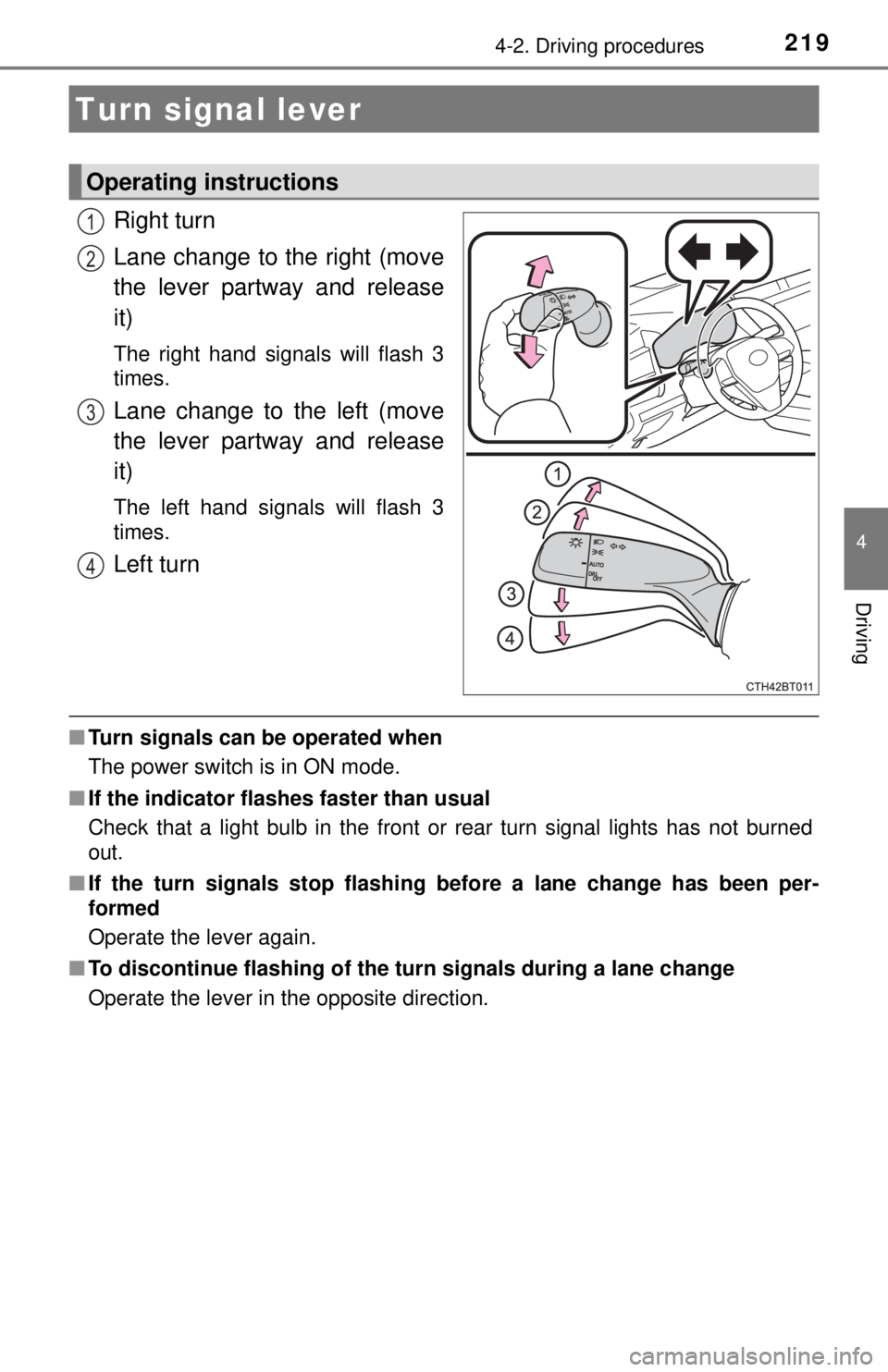
2194-2. Driving procedures
4
Driving
Right turn
Lane change to the right (move
the lever partway and release
it)
The right hand signals will flash 3
times.
Lane change to the left (move
the lever partway and release
it)
The left hand signals will flash 3
times.
Left turn
■Turn signals can be operated when
The power switch is in ON mode.
■ If the indicator flashes faster than usual
Check that a light bulb in the front or rear turn signal lights has not burned
out.
■ If the turn signals stop flashing before a lane change has been per-
formed
Operate the lever again.
■ To discontinue flashing of the turn signals during a lane change
Operate the lever in the opposite direction.
Turn signal lever
Operating instructions
1
2
3
4
Page 232 of 596

2324-3. Operating the lights and wipers
■Conditions to turn the high beams on/off automatically
●When all of the following conditions are met, the high beams will be turned
on automatically (after approximately 1 second):
• The vehicle speed is approximately 21 mph (34 km/h) or more.
• The area ahead of the vehicle is dark.
• There are no vehicles ahead with headlights or tail lights turned on.
• There are few streetlights on the road ahead.
● If any of the following conditions is met, the high beams will turn off automat-
ically:
• The vehicle speed is below approximately 17 mph (27 km/h).
• The area ahead of the vehicle is not dark.
• Vehicles ahead have their headlights or tail lights turned on.
• There are many streetlights on the road ahead.
■ Camera sensor detection information
●The high beams may not be automatically turned off in the following situa-
tions:
• When a vehicle suddenly appears from around a curve
• When the vehicle is cut in front of by another vehicle
• When vehicles ahead cannot be detected due to repeated curves, road
dividers or roadside trees
• When vehicles ahead appear in a faraway lane on a wide road
• When the lights of vehicles ahead are not on
● The high beams may be turned off if a vehicle ahead that is using fog lights
without its headlights turned on is detected.
● House lights, street lights, traffic signals, and illuminated billboards or signs
and other reflective objects may cause the high beams to change to the low
beams, or the low beams to remain on.
● The following factors may affect the amount of time taken for the high
beams to turn on or off:
• The brightness of the headlights, fog lights, and tail lights of vehicles
ahead
• The movement and direction of vehicles ahead
• When a vehicle ahead only has operational lights on one side
• When a vehicle ahead is a two-wheeled vehicle
• The condition of the road (gradient, curve, condition of the road surface,
etc.)
• The number of passengers and amount of luggage in the vehicle
● The high beams may turn on or off unexpectedly.
● Bicycles or similar vehicles may not be detected.
Page 266 of 596
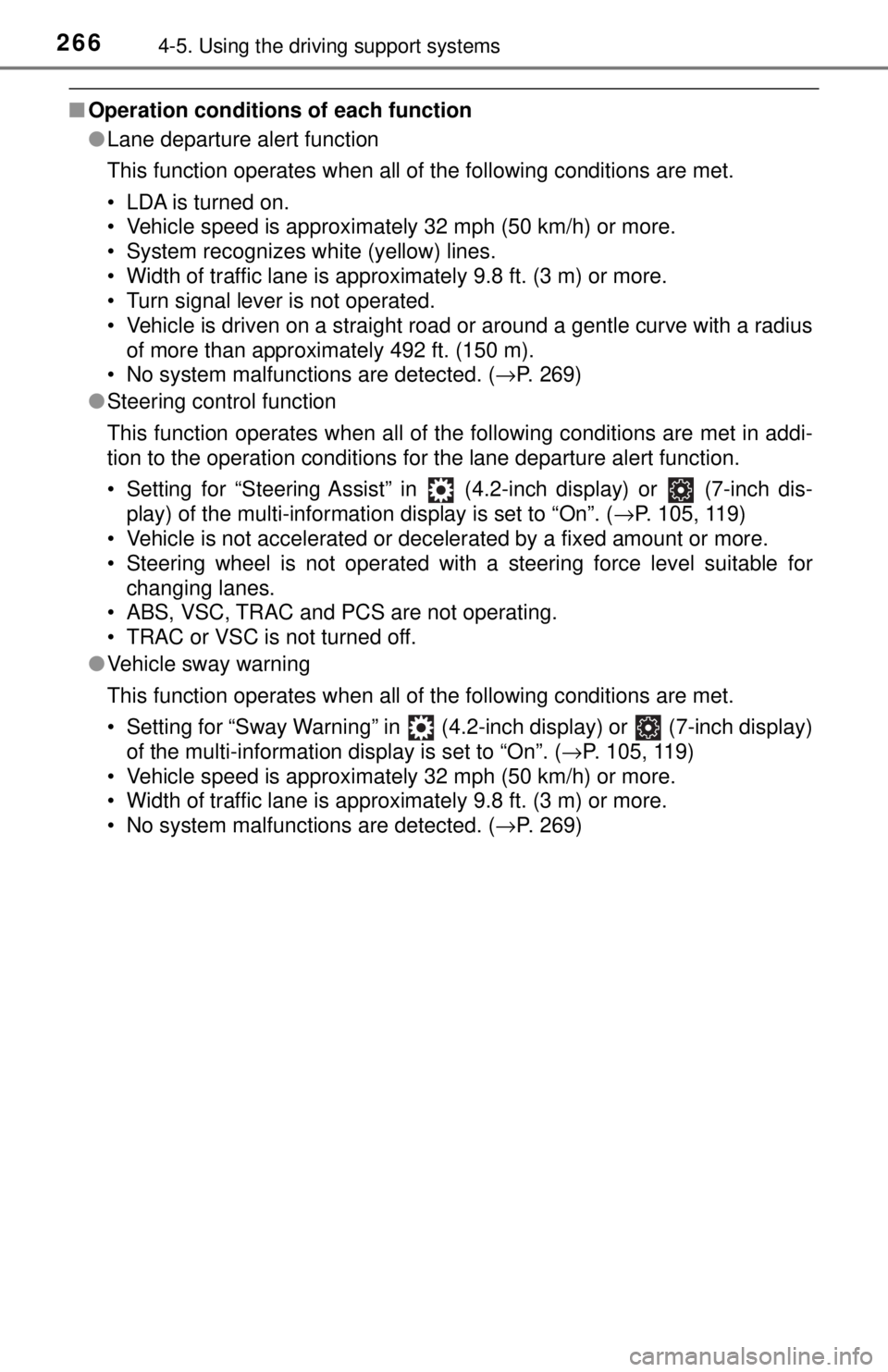
2664-5. Using the driving support systems
■Operation conditions of each function
●Lane departure alert function
This function operates when all of the following conditions are met.
• LDA is turned on.
• Vehicle speed is approximately 32 mph (50 km/h) or more.
• System recognizes white (yellow) lines.
• Width of traffic lane is approximately 9.8 ft. (3 m) or more.
• Turn signal lever is not operated.
• Vehicle is driven on a straight road or around a gentle curve with a radius
of more than approximately 492 ft. (150 m).
• No system malfunctions are detected. ( →P. 269)
● Steering control function
This function operates when all of the following conditions are met in addi-
tion to the operation conditions for the lane departure alert function.
• Setting for “Steering Assist” in (4.2-inch display) or (7-inch dis-
play) of the multi-information display is set to “On”. ( →P. 105, 119)
• Vehicle is not accelerated or decelerated by a fixed amount or more.
• Steering wheel is not operated with a steering force level suitable for
changing lanes.
• ABS, VSC, TRAC and PCS are not operating.
• TRAC or VSC is not turned off.
● Vehicle sway warning
This function operates when all of the following conditions are met.
• Setting for “Sway Warning” in (4.2-inch display) or (7-inch display)
of the multi-information display is set to “On”. ( →P. 105, 119)
• Vehicle speed is approximately 32 mph (50 km/h) or more.
• Width of traffic lane is approximately 9.8 ft. (3 m) or more.
• No system malfunctions are detected. ( →P. 269)
Page 290 of 596
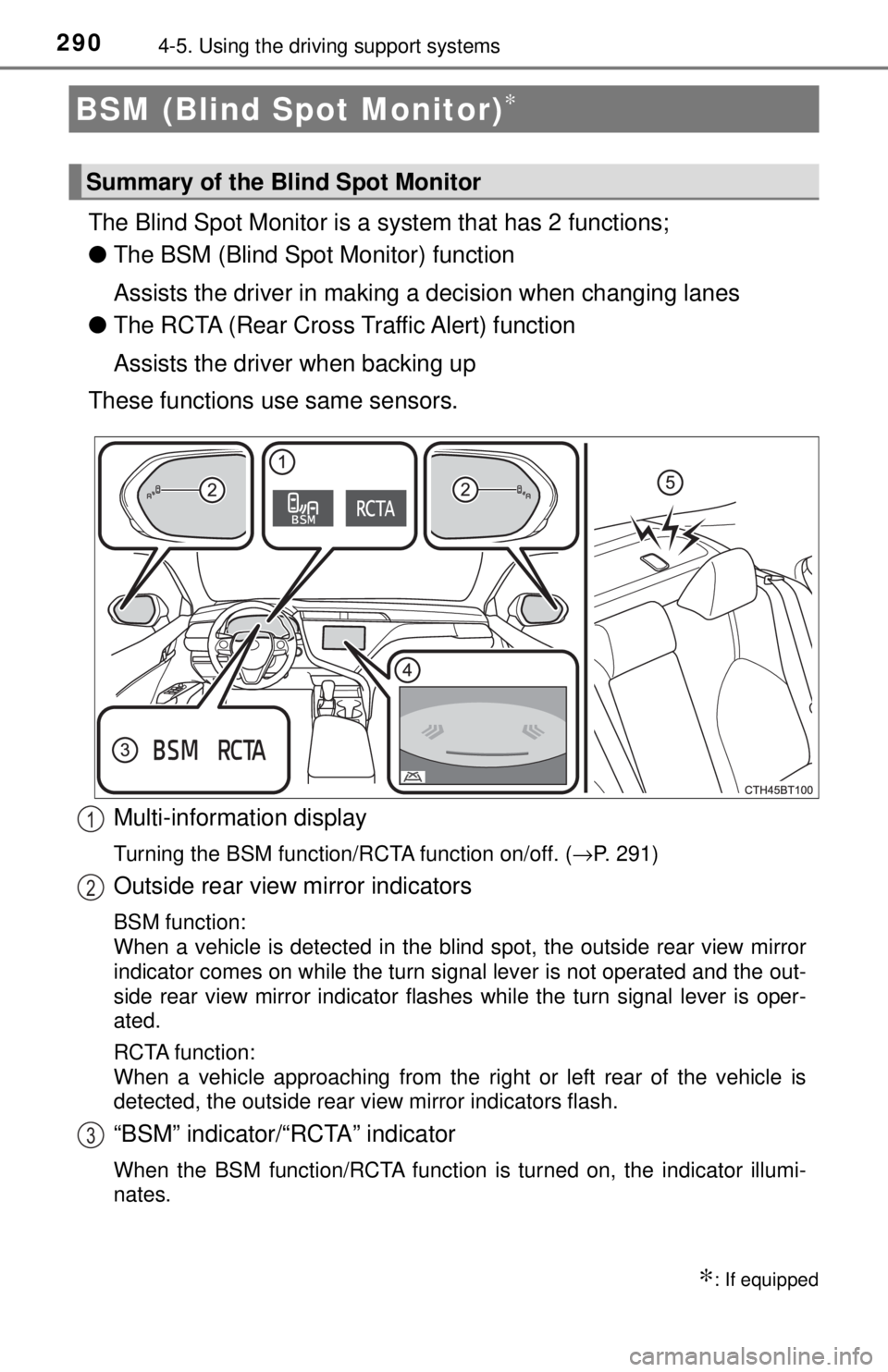
2904-5. Using the driving support systems
The Blind Spot Monitor is a system that has 2 functions;
● The BSM (Blind Spot Monitor) function
Assists the driver in making a decision when changing lanes
● The RCTA (Rear Cross Traffic Alert) function
Assists the driver when backing up
These functions use same sensors.
BSM (Blind Spot Monitor)∗
∗: If equipped
Summary of the Blind Spot Monitor
Multi-information display
Turning the BSM function/RCTA function on/off. ( →P. 291)
Outside rear view mirror indicators
BSM function:
When a vehicle is detected in the blind spot, the outside rear view mirror
indicator comes on while the turn signal lever is not operated and the out-
side rear view mirror indicator flashes while the turn signal lever is oper-
ated.
RCTA function:
When a vehicle approaching from the right or left rear of the vehicle is
detected, the outside rear view mirror indicators flash.
“BSM” indicator/“RCTA” indicator
When the BSM function/RCTA function is turned on, the indicator illumi-
nates.
1
2
3